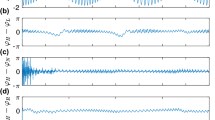Abstract
An analysis method to detect the presence of feedback between biological signals, particularly those associated with the central nervous system, is presented. The technique is based on recent results in the system identification literature involving the concept of a feedback free process. It may be applied to volume conducted signals such as EEG and EMG, as well as to neuronal spike trains through the use of a data transformation procedure. The utility of the technique is then demonstrated in a study of the relationship between Parkinsonian tremor and certain tremor cells found in the thalamus of Parkinsonian patients, using data collected during thalamotomies. The results obtained suggest that feedback mechanisms may be an important factor contributing to Parkinsonian tremor.
Similar content being viewed by others
References
Akaike H (1976) Canonical correlation analysis of time series and the use of an information criterion. In: Mehra RK, Lainiotis DG (eds) System identification: advances and case studies. Academic Press, New York, pp 27–96
Alberts WW, Libet B, Wright EW, Feinstein B (1965) Physiological mechanisms of tremor and rigidity in Parkinsonism. Confin Neurol 26:318–327
Anderson BDO, Gevers MR (1982) Identifiability of linear stochastic systems operating under linear feedback. Automatica 18:195–213
Benignus VA (1969) Estimation of the coherence spectrum and its confidence interval using the fast Fourier transform. IEEE Trans Audio Electroacoust AU-17:145–150
Caines PE (1976) Weak and strong feedback free processes. IEEE Trans AC-21:737–739
Caines PE, Chan CW (1975) Feedback between stationary stochastic processes. IEEE Trans AC-20:498–508
Caines PE, Chan CW (1976) Estimation, identification, and feedback. In: Mehra RK, Lainiotis DG (eds) System identification: advances and case studies. Academic Press, New York, pp 349–405
Cheney PD, Fetz EE (1984) Corticoneuronal cells contribute to long-latency stretch reflexes in the rhesus monkey. J Physiol 349:249–272
Desmedt DE (1978) Progress in clinical neurophysiology, cerebral motor control in man: long loop mechanisms, vol 4. Karger, Basel
Evarts EV, Tervainen H, Beuchert DE, Calne DB (1979) Pathophysiology of motor performance in Parkinson's disease. In: Fuxe K, Calne DB (eds) Dopaminergic ergot derivatives and motor functions. Pergamon Press, London, pp 45–59
Foerster O (1911) Resection of the posterior nerve roots of spinal cord. Lancet II:76–79
French AS, Holden AV (1971) Alias-free sampling of neuronal spike trains. Kybernetik 8:165–171
Gaze RM, Gillingham FJ, Kalyanaraman S, Porter RW, Donaldson AA, Donaldson IML (1964) Microelectrode recordings from the human thalamus. Brain 87:691–706
Gevers MR, Anderson BDO (1981) Representations of jointly stationary stochastic feedback processes. Int J Contr 33:777–809
Gevers MR, Anderson BDO (1982) On jointly stationary feedback-free stochastic processes. IEEE Trans AC-27:431–436
Granger CWJ (1969) Investigating causal relations by econometric models and cross-spectral methods. Econometrica 37:424–438
Jones RH (1974) Identification and autoregressive spectrum estimation. IEEE Trans AC-19:894–897
Kailath T (1980) Linear systems. Prentice-Hall, Englewood Cliffs, NJ
Lamarre Y, Joffroy AJ (1979) Experimental tremor in monkey: activity of thalamic and precentral cortical neurons in the absence of peripheral feedback. Adv Neurol 24:109–122
Lee RG, Stein RB (1981) Resetting of tremor by mechanical perturbations: a comparison of essential tremor and Parkinsonian tremor. Ann Neurol 10:523–531
Lee RG, Tatton WG (1975) Motor responses to sudden limb displacements in primates with specific CNS lesions and in human patients with motor system disorders. Can J Neurol Sci 2:285–293
Lenz FA, Tasker RR, Kwan HC, Schnider S, Kwong R, Murphy JT (1985) Single unit analysis of the ventral tier of lateral thalamic nuclei in patients with Parkinsonian tremor. Soc Neurosci 11:1164 (abstr)
Lenz FA, Tasker RR, Kwan HC, Schnider S, Kwong R, Murphy JT (1986) Cross-correlation analysis of thalamic “tremor cells” in patients with Parkinsonian tremor. Appl Neurophysiol 48:305–309
Lenz FA, Tasker RR, Kwan HC, Schnider S, Kwong R, Marayama Y, Dostrovsky JO, Murphy JT (1988) Single unit analysis of the human ventral thalamic nuclear group: correlation of thalamic “tremor cells” with the 3–6 Hz component of Parkinsonian tremor. J Neurosci 8:754–764
Marsden CD (1984) Origins of normal and pathological tremor in movement disorders. In: Findley LJ, Capildeo R (eds) MacMillan, London, pp 37-85
Saito Y, Harashima H (1981) Tracking of informations within multichannel EEG record — causal analysis in EEG. In: Yamaguchi N, Fujisawa K (eds) Recent advances in EEG and EMG data processing, Elsevier/North-Holland, Amsterdam, pp 133–146
Schnider S. (1985) Detection of feedback in the central nervous system of Parkinsonian patients using system identification techniques. M.A. Sc. Thesis, University of Toronto
Sin KS, Goodwin GC (1980) Checkable conditions for identifiability of linear systems operating in closed loop. IEEE Trans AC-25:722–729
Stein RB, Lee RG (1981) Tremor and clonus. In: Brooks VB (eds) Handbook of physiology: motor control, vol 1. American Physiological Society, Bethesda
Stein RB, Oguztoreli MN (1976) Tremor and other oscillations in neuromuscular systems. Biol Cybern 22:147–157
Steriade M, Deschennes M (1984) The thalamus as a neuronal oscillator. Brain Res Rev 8:1–63
Tatton WG, Bedingham W, Verrier MC, Blair RDG (1984) Characteristic alterations in responses to imposed wrist displacements in Parkinsonian rigidity and dystonia musculorum deformans. Can J Neurol Sci 11:281–287
Teravainen H, Evarts E, Calne D (1979) Effects of kinesthetic inputs on Parkinsonian tremor. Adv Neurol 24:161–173
Whittle P (1963) On the fitting of multivariable autoregressions, and the approximate canonical factorization of a spectral density matrix. Biometrika 50:129–134
Author information
Authors and Affiliations
Additional information
This research was supported by the Natural Sciences and Engineering Research Council of Canada, The Medical Research Council of Canada, and Bell-Northern Research
Rights and permissions
About this article
Cite this article
Schnider, S.M., Kwong, R.H., Lenz, F.A. et al. Detection of feedback in the central nervous system using system identification techniques. Biol. Cybern. 60, 203–212 (1989). https://doi.org/10.1007/BF00207288
Received:
Issue Date:
DOI: https://doi.org/10.1007/BF00207288




